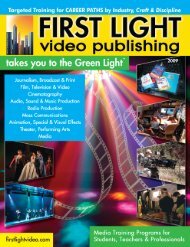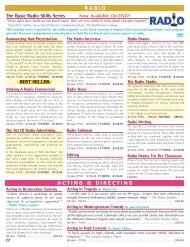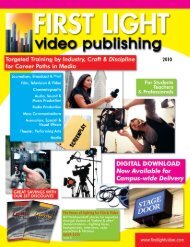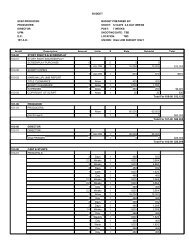to download Safety Manual & Checklist - First Light Video
to download Safety Manual & Checklist - First Light Video
to download Safety Manual & Checklist - First Light Video
Create successful ePaper yourself
Turn your PDF publications into a flip-book with our unique Google optimized e-Paper software.
Stands and Rigging<br />
The Grips are responsible for all rigging, meaning anything that needs <strong>to</strong> be hung or<br />
put on a stand. This includes the setting of light stands. When carrying a stand, the<br />
warning “points coming through” should be yelled out so crew members can move out<br />
of the way of the possible hazard. All stands in use on the set must be sand-bagged<br />
according <strong>to</strong> their load or precariousness of their position.<br />
C-stands must be set correctly. A C-stand’s arm is designed <strong>to</strong> extend over the knuckle<br />
with the load on the side <strong>to</strong>ward which the knuckle tightens. This way, if the load forces<br />
the arm <strong>to</strong> slip, it will actually tighten and s<strong>to</strong>p. If the rear of the C-Stand arm extends<br />
out beyond the base, a marker should be attached <strong>to</strong> it so that it can clearly be seen.<br />
This is true of any equipment or prop on set which sticks out and is particularly critical<br />
if something sticks out at eye-level.<br />
Dollies<br />
Grips are also responsible for the dolly. Once dolly tracks have been set, the crew<br />
must be careful not <strong>to</strong> trip on the tracks.<br />
Heavy dollies should not be lifted, but ramped on<strong>to</strong> their tracks with wedges. Once on<br />
the track, the dolly should be prevented from rolling off the track with clamps<br />
The Dolly Grip is the only crew member permitted <strong>to</strong> operate the dolly. Except during<br />
an actual take, the dolly grip must always warn those on and around the dolly before<br />
moving the dolly, yelling “dolly moves!” or “boom going up!” Crew members must<br />
always let the dolly group know their intention <strong>to</strong> mount or dismount the dolly before<br />
doing so, usually by saying “stepping on” or “stepping off”.<br />
Nutrition and Hydration<br />
Food and drinks should be available <strong>to</strong> crew members throughout the entire shoot.<br />
Craft services keeps a crew happy, but more importantly, crew members who lack<br />
energy or focus are a hazard on set.<br />
Snacks should include fruits and vegetables as well as snack bars and candy bars.<br />
Drinks should offer both caffeinated and decaffeinated options.<br />
Working with Talent<br />
Particular care must be taken with talent. Ac<strong>to</strong>rs should not be expected <strong>to</strong> be as<br />
aware of the possible hazards on a set as crew members. It is the AD’s responsibility<br />
<strong>to</strong> get the ac<strong>to</strong>rs <strong>to</strong> the set and make them aware of any hazards.<br />
If child ac<strong>to</strong>rs or animals are on set, they must have a crew member assigned <strong>to</strong> watch<br />
them at all times. For Advanced Productions, a Studio Teacher must be hired anytime<br />
a child ac<strong>to</strong>r is on set.<br />
During the Shoot<br />
As shooting begins, the entire crew needs <strong>to</strong> stay aware of possible hazards. Any possible<br />
safety concern should be reported <strong>to</strong> the AD promptly.<br />
Watch out for burning smells, trip hazards, clear paths <strong>to</strong> fire exits, damaged equipment,<br />
or unsafe behavior by crew members or talent.<br />
Late arriving crew members must be briefed individually on safety by the AD.<br />
4<br />
Fire, Stunts, and Firearms<br />
Candles and cigarettes should be handled with great care on a set. Any larger fire<br />
used on set, even a large group of candles, must be supervised by a paid Fire<br />
Marshal.<br />
All stunts should be planned by a professional. Crew members need <strong>to</strong> be made<br />
aware of all aspects of any stunt before it is executed, and should watch for related<br />
hazards.<br />
If weapons of any kind, including guns, swords, and knives are <strong>to</strong> be used on a production,<br />
local law enforcement must be notified, even if the weapons are non-functioning<br />
replicas <strong>to</strong> be used on a closed set.<br />
The use of functioning firearms, even with blanks, should be avoided. Remember, realistic<br />
muzzle flash can very easily be added in post. Functioning firearms must be handled<br />
by a professional. The weapons specialist must only allow the ac<strong>to</strong>r whose part<br />
requires handling the weapon <strong>to</strong> handle the weapon during actual filming, and no one<br />
else should ever handle the weapon. When not in use, weapons should be s<strong>to</strong>red in a<br />
locked location. This goes for replicas or functioning firearms.<br />
Driving Shots<br />
Any shot sequences that involve moving vehicles must be approved planned for in<br />
advanced in a way that assures their safety. A process trailer should be used in cases<br />
where ac<strong>to</strong>rs cannot safely operate a mo<strong>to</strong>r vehicle at the same time they are focused<br />
on delivering a performance. Local law enforcement must be made aware of any situations<br />
involving the shooting of moving vehicles on public streets and in some case may<br />
need <strong>to</strong> restrict traffic in the shooting area.<br />
Meal Breaks<br />
A meal must always be served no more than six hours after crew call. All meals should<br />
be nutritionally balanced, and enough must be provided for the entire crew and cast.<br />
Everyone in the cast and crew should get at least half an hour <strong>to</strong> eat.<br />
Company Moves<br />
Should it be necessary <strong>to</strong> change locations in the middle of a shooting day, the company<br />
move must be handled carefully in spite of the temptation <strong>to</strong> rush <strong>to</strong> the next location.<br />
A safety meeting must be held at the new location before filming resumes.<br />
Even for a short move, all equipment should be s<strong>to</strong>wed securely in the production<br />
vehicles.<br />
Shooting Outdoors<br />
Film shoots always attract the curious. Particularly when outside, the crew needs <strong>to</strong><br />
watch out for individuals who are not part of the film shoot and keep them clear of all<br />
equipment and the shooting area in general. Report anyone who does not belong on<br />
the set <strong>to</strong> the AD.<br />
Shooting should not occur on public or private roads open <strong>to</strong> traffic. Contact local law<br />
enforcement or the property’s owners <strong>to</strong> close the area <strong>to</strong> traffic.<br />
Under no circumstances should lights or rigging of any kind be set up anywhere near<br />
power lines or overhead lines of any kind.<br />
5






